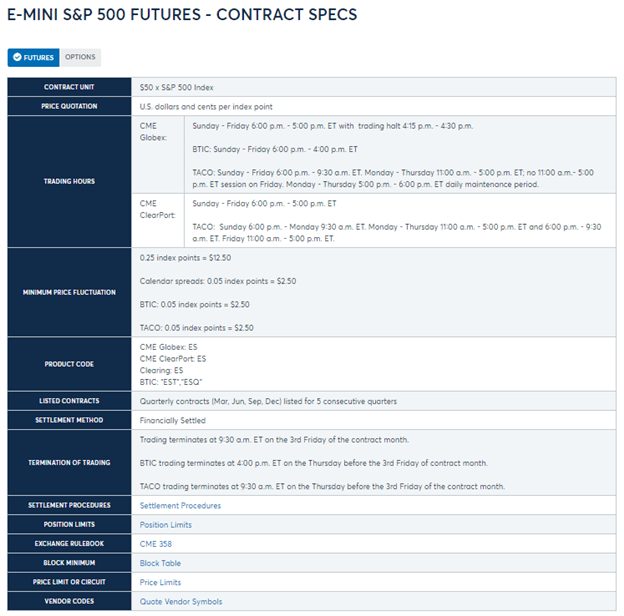Futures Trading 101: Understanding the Basics
The futures markets offer an excellent way for traders to express their views on various asset classes. For example, when trading the S&P 500 you can establish a position in a number of ways – everything from ETFs (exchange traded funds) to options tofutures.



The futures market is appealing as it offers significant amounts of liquidity in stock indices, commodities, currencies, interest rates, and select cryptocurrencies. Futures are traded in a centralized manner via regulated exchanges, offer the flexibility to go long or short, have extensive trading hours, and provide the ability to apply leverage.
To trade futures you will need to open an account with a futures broker, where you place the trades that then get routed to the exchange for execution. All of this is done on the backend at your broker similarly to how one trades stocks, options, and FX.
Contract Specifications
On the websites of the various exchanges that offer futures, you will find the contract specifications (“Contract Specs”) with all the pertinent details you need to know about the contract you are considering to trade. The following are the most important details you should know.
Product code is the ticker symbol. For example, the e-mini S&P 500 futures contract product code is “ES”. Contract unit tells you how much of the ‘underlying’ the contract represents and provides you with a multiplier. For instance, the ES contract has a total contract value that is $50 x S&P 500 price ($50 x $4150) = $207,500.
Trading hours vary from contract to contract, but most contracts these days trade for the better part of 24-hours over a 5-day week. However, this does not mean liquidity is good over the course of a 24-hour cycle, so you want to investigate the different contracts and identify liquidity patterns. Liquidity is typically best during local business hours.
Minimum price fluctuation tells you at what increments the contracts change and what they are worth. For example, WTI crude oil (CL) trading on the NYMEX has a minimum price fluctuation of $0.01 per barrel, which is equal to $10. For every penny crude oil moves your profit and loss on one contract will move by $10. A $1 move in the price of WTI is equal to $1000 (100 cents x $10 = $1,000).
Listed contracts tell you what month or quarter the contract represents. Each month is denoted by a letter and can be found on the exchange’s website. For example, “H” is used for the month of March. Then at the end of the code is the year. For instance, if you are trading the March 2021 e-mini S&P 500 contract, the ticker symbol will be “ESH21”:
Settlement method informs you whether it is a deliverable (i.e., commodities such as oil) or settles financially (i.e., stock index futures). Traders don’t hold to settlement, contracts are exited or rolled to the nearest front month contract.
Termination of trading tells you when the contract no longer trades. It is typically the third Friday of the expiration date, but varies by contract.

Margin and Leverage Factor
Margin and leverage are considerations of risk management, which is one of the most important factors to good trading. This is also where maybe the biggest misconceptions lies with respect to futures – that they are dangerous because of the available leverage and limited margin required to hold a position. But just because leverage is available doesn’t mean you have to use it, and in fact responsible trading entails only using minimal amounts of leverage. More on that just below, but first a few definitions to understand.
Margin is the amount of capital needed to buy or sell one futures contract. You can think of it as a deposit. It works similarly to margin in other leveraged products, whether it be spot FX (“Forex”), stocks, or another financial asset. In futures there are two kinds of margin: initial margin and maintenance margin. The initial margin is the amount that is required by the exchange to enter into a position, while the maintenance margin is the minimum amount that is required in your account to continue holding the futures contract(s). If your account declines below the maintenance level you may get a ‘margin call’ that will require you to add funds to your account to bring the account balance up to the initial margin level, or you may be forced to liquidate the position.
Typically, the margin rate will range between 3% and 12% of the total notional contract value. For example, if the total value of one contract is $100k and the margin is 10%, then only $10k margin is needed to enter into a single contract. You will be able to get margin requirements from your futures broker.
It is obviously not ideal to trade at the margin, literally, so you want to make sure that you are capitalized well beyond the margin requirements to ensure your leverage factor is reasonable. For example, if on an account with a cash balance of $10k a trader buys a futures contract with a notional value of $20k, the leverage factor would be 2:1 ($20k notional contract value / $10k cash balance). The margin, however, to enter the position might only be 10% of the contract value, and so the margin required would be $2k. With an account balance of $10k the trader is well capitalized beyond the margin requirement and demonstrating good risk management with a leverage factor of 2:1.
Summary
- Futures are traded on regulated exchanges and can be accessed through a futures broker similarly to other markets such as stocks, options, and currencies
- Contracts are available on the all the major asset classes; equity indices, commodities, interest rates, and currencies
- It is important to understand the contract specifications of the market you are trading
- Leverage is available, but keep in mind it needs to be used responsibly within a risk management framework






